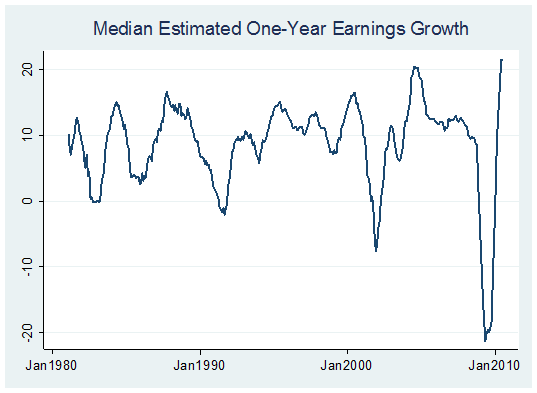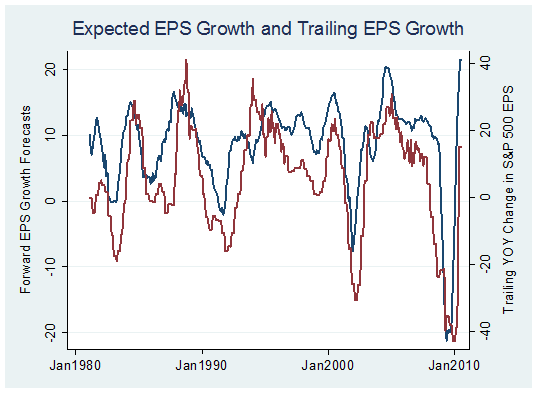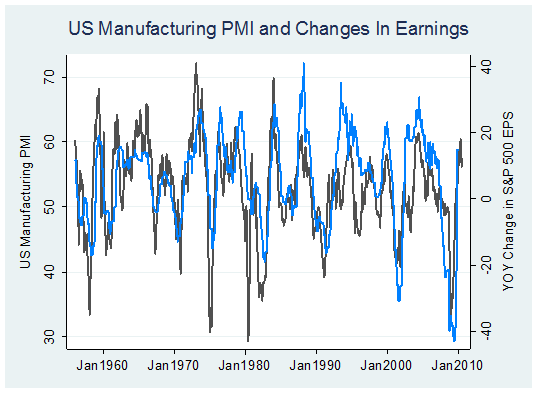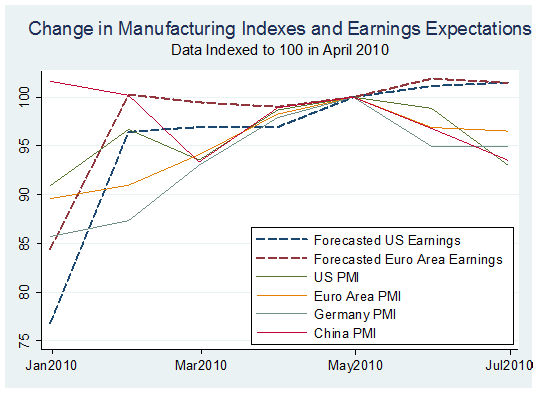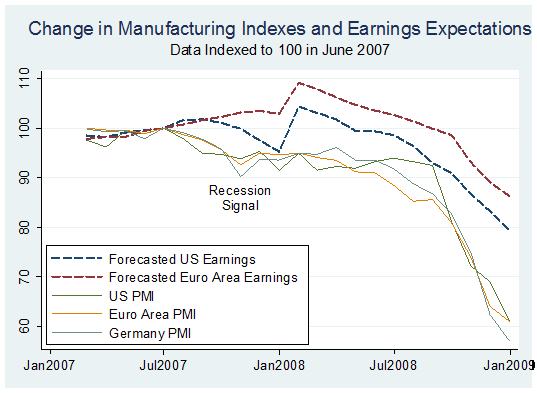|  |

October 3, 2010 Economic Measures Continue to Slow
John P. Hussman, Ph.D.
All rights reserved and actively enforced.
Reprint Policy
The latest evidence from a variety of economic measures continues to suggest deterioration in U.S. economic activity. Probably the best way to characterize the latest round of data from the ISM and other surveys is that the data is coming in a bit less negative than we've anticipated, but continues to deteriorate in a manner that is consistent with stagnant economic activity.
To obtain a broad indication of economic performance, we averaged eight different measures reported by the ISM and the Federal Reserve. These included the ISM National, Chicago, Cincinnati and Milwaukee surveys, as well as the Federal Reserve's Empire Manufacturing, Philadelphia, Richmond and Dallas surveys. The chart below shows the average standardized value of the overall indices, as well as the new orders and backlogs components (a standardized value subtracts the mean and divides by the standard deviation of a given series, so all of the variables are essentially Z scores).
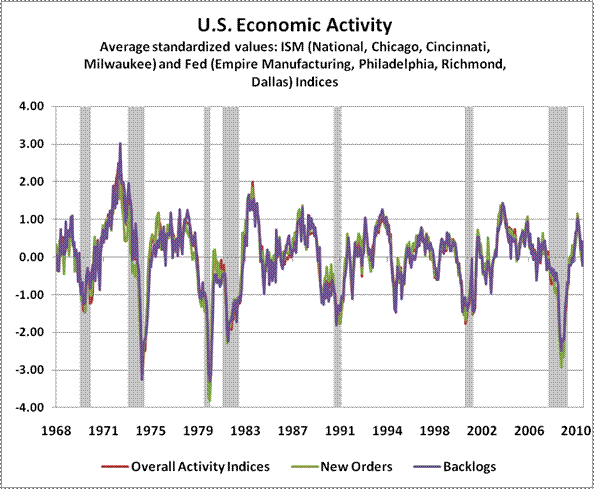
Closer inspection shows that all of these measures dropped below zero last month. That said, these measures are not as negative as what we observe from the ECRI Weekly Leading Index. Taken by itself, this data implies tepid economic growth, but not outright contraction.
Still, with the S&P 500 at a Shiller P/E over 21, and our own measures indicating an estimated 10-year total return for the S&P 500 in the low 5% area, it is clear that investors have priced in a much more robust recovery than we are likely to observe. Our long-term total return estimates are consistent the historical norms based on Shiller P/Es - since 1940, Shiller P/E values above 21 have been associated with annual total returns for the S&P 500 averaging 5.3% over the following 7 years and 4.9% annually over the following decade.
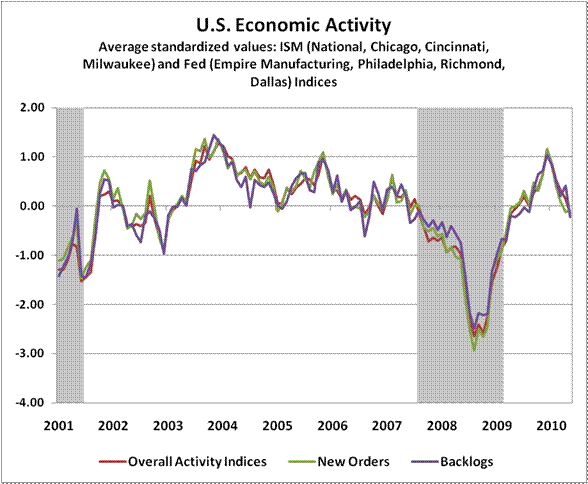
The activity indices presented above are closely correlated with GDP growth. On that note, second quarter GDP growth was revised last week to 1.7% annualized, which was up slightly from the first revision of 1.6% growth, but down from the initial estimate of 2.4%. Based on what we observe in other data, third quarter GDP is likely to reflect continued tepid growth, though the overall activity indices did not decline enough to suggest that the economy contracted in the third quarter. Unfortunately, if we look historically at 6-month periods where real GDP achieved positive growth, but less than about 2.5% annualized and slower than the prior 6 month span, the S&P 500 has historically achieved zero total return, on average, during those periods. Slow, positive economic growth is only helpful for the market, on average, when that growth represents an acceleration.
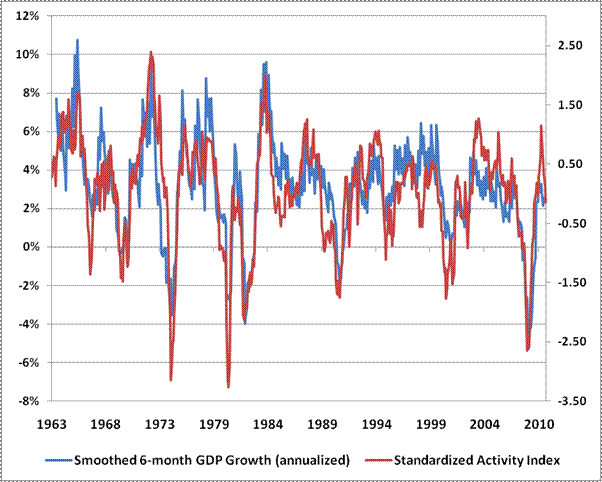
Dividend payout ratios and operating earnings growth
A note on valuation. A number of observers have suggested that the low level of dividend payouts as a fraction of operating earnings is indicative of strong prospects for reinvestment, which is then extrapolated into assumptions for high rates of future earnings growth. Unfortunately, this argument is problematic on two counts.
First, forward operating earnings are not realized cash flows. As I've noted frequently over the years, forward operating earnings represent analyst estimates of the next year's earnings excluding a whole range of chargeoffs and "extraordinary expenses" as if they do not exist. While operating earnings provide a smoother measure of business performance, they don't provide a good measure of the cash flows that are actually deliverable to shareholders.
Losses that are booked as "extraordinary" are still losses, and represent the results of bad investments and a consumption of amounts that were previously reported as earnings. Similarly, the portion of earnings used for share buybacks is often expended simply to offset dilution from grants of stock to employees and corporate insiders, and again do not reflect cash that is deliverable to shareholders. In recent years, based on the widening gap between reported operating earnings on one hand, and the sum of dividends and increments to book value on the other, a great deal of what is reported as earnings ends up evaporating as extraordinary losses and share compensation.
The second problem with the low level of dividend payouts, relative to forward operating earnings, is that there is no historical evidence whatsoever that low payouts are accompanied by higher growth in future operating earnings. To the contrary, when dividends are low relative to forward operating earnings, it is a signal that operating earnings are temporarily elevated - typically because of transitory profit margins. As a result, subsequent growth in forward earnings is actually slower than normal over the following decade.
Dividend policy is set in a very forward-looking manner. Since dividend cuts generally result in very negative events for corporations, dividend payments are set to a level that management believes it can sustain. Relative to current forward operating earnings, indicated dividend payments are near the lowest level on record. If anything, investors should take this as a signal that managements do not expect present levels of earnings to be sustained at a level that is sufficient to justify higher payouts.
In contrast, high dividend payouts (as a ratio of forward operating earnings) typically reflect temporarily depressed operating earnings, and short-term margin compression. Accordingly, elevated payouts tend to be followed by above average growth in operating earnings over the following decade. The tendency for dividend payouts to lead operating earnings growth is depicted below (see Long Term Evidence on the Fed Model and Forward Operating P/E Ratios for details on forward operating earnings prior to 1979). Suffice it to say that the low level of payouts today most likely reflects elevated and unsustainable operating margins.
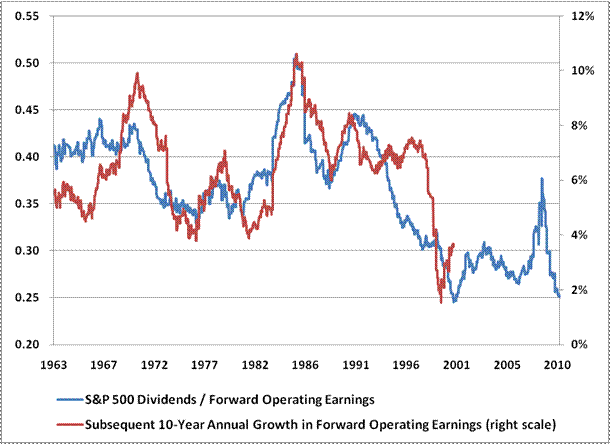
On the latitude for a constructive investment stance
Based on the data that we've observed in recent months, my view remains that a fresh downturn in the economy remains a not only a possibility but a likelihood. Little of the economic improvement we've observed since 2009 appears intrinsic, but instead appears driven by enormous government interventions that are now trailing off. Still, while I believe that there is a second shoe that has not dropped, I recognize that the full force of government policy is to obscure, stimulate, intervene and borrow in every effort to kick that can down the road. I believe that the unaddressed and unresolved problems relating to debt service, employment conditions and housing are too large for this to be successful, but as we move through the remainder of this year - as I've said throughout 2010 - we are gradually assigning greater probability to the "post-1940" dataset. Accordingly, there are developments that could potentially move us to a more constructive position. We don't observe those at present, but an improvement in economic evidence and a clearing of overbought conditions, leaving market internals intact, would be one configuration that might warrant less defensiveness.
How constructive is "constructive"? Without an improvement in valuation levels, a constructive investment exposure for us here would likely be limited to a removal of perhaps 20% of our hedges, because the improvement in expected return and reduction in expected risk will not be dramatic unless valuations retreat sharply. That said, we occasionally observe conditions that warrant placing about 1-2% of assets into call options, which would allow a subsequent market advance to soften our hedges without actually removing the put option side of our defenses.
A better configuration would include a significant retreat in valuations and a massive, if uncomfortable, amount of debt restructuring. Those two events would be the best way to put the recent (and probably ongoing) debt crisis behind us, and could easily allow us to completely lift our hedges for an extended period of time in anticipation of an unobstructed recovery.
To some extent, I view current market conditions as something of a "Ponzi game" in that valuations appear neither sustainable nor likely to produce acceptably high long-term returns, and speculators increasingly rely on finding a greater fool. As the mathematician John Allen Paulos has observed, "people generally worry only about what happens one or two steps ahead and anticipate being able to get out before a collapse... In countless situations people prepare exclusively for near-term outcomes and don't look very far ahead. They myopically discount the future at an absurdly steep rate." Undoubtedly, we have periodically missed returns due to our aversion to risks that rely on the ability to find a "greater fool" in order to get out safely. But it is important to recognize that speculative risks are not a source of durable long-term returns. At a Shiller P/E of 21 and a historical peak-to-peak S&P 500 earnings growth rate of 6%, a simple reversion to the historical (non-bubble) Shiller norm of 14 would require seven years of earnings growth and yet zero growth in prices. Stocks are not cheap here.
Meanwhile, the U.S. financial system appears to be a nicely painted dam, behind which a massive pool of delinquent debt is obscured. A significant correction in valuations and resolution of the growing backlog of delinquent debt may finally restore strong "investment merit" to the U.S. stock market, but only after a greater amount of pain and adjustment than most investors seem to anticipate.
In general, we want to take risk in proportion to the improvement we observe in the return that we expect per unit of that risk, primarily based on long-term historical evidence about what has occurred in similar conditions. For now, we remain defensive.
Market Climate
As of last week, the Market Climate for stocks was characterized by rich valuations, elevated (but not extreme) bullish sentiment, generally positive but overbought price trends, and continued negative economic pressures. Overall, our measures suggest an overvalued, overbought, overbullish condition, but with shorter term factors struggling between emerging economic weakness and overbought conditions on the negative side, and speculative trend following on the positive side. For our part, the current set of conditions is associated with an unfavorable return/risk profile, so the Strategic Growth Fund and the Strategic International Equity Fund remain well hedged.
In bonds, the Market Climate last week was characterized by moderately unfavorable yield levels and positive yield pressures. The Strategic Total Return Fund continues to carry a portfolio duration of just over 4 years, mostly in straight Treasury securities. We've clipped a small portion of our precious metals holdings on strength in order to hold our exposure to roughly 10% of assets, but the overall Market Climate remains favorable in that sector for now. The Fund continues to hold about 5% of assets in foreign currencies and about 2% of assets in utility shares.


